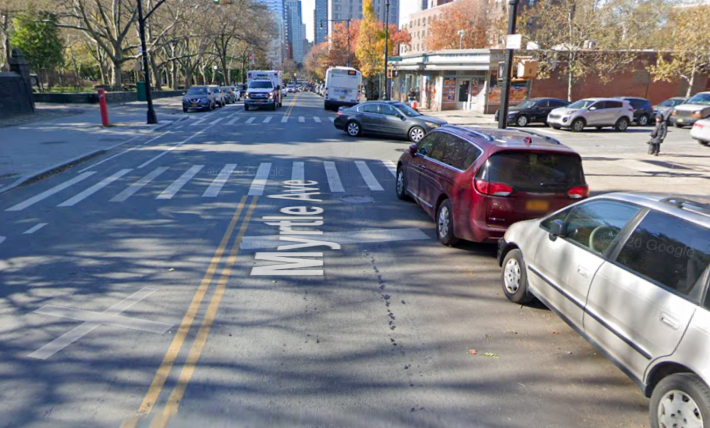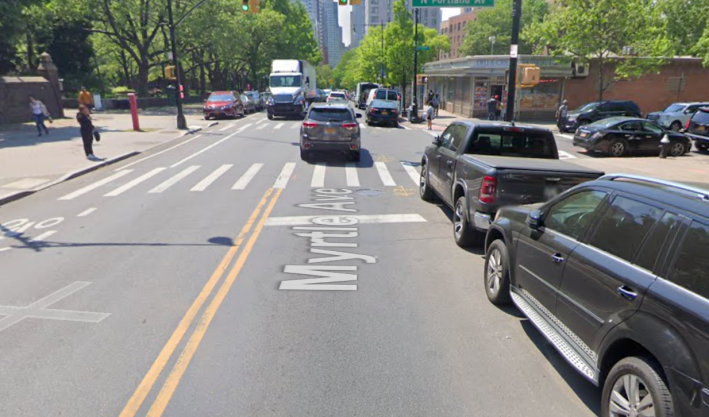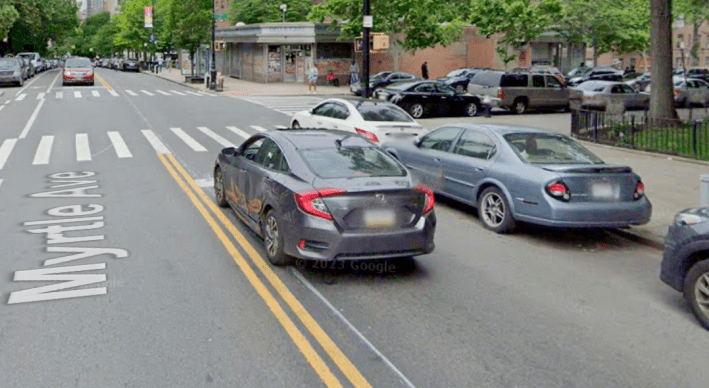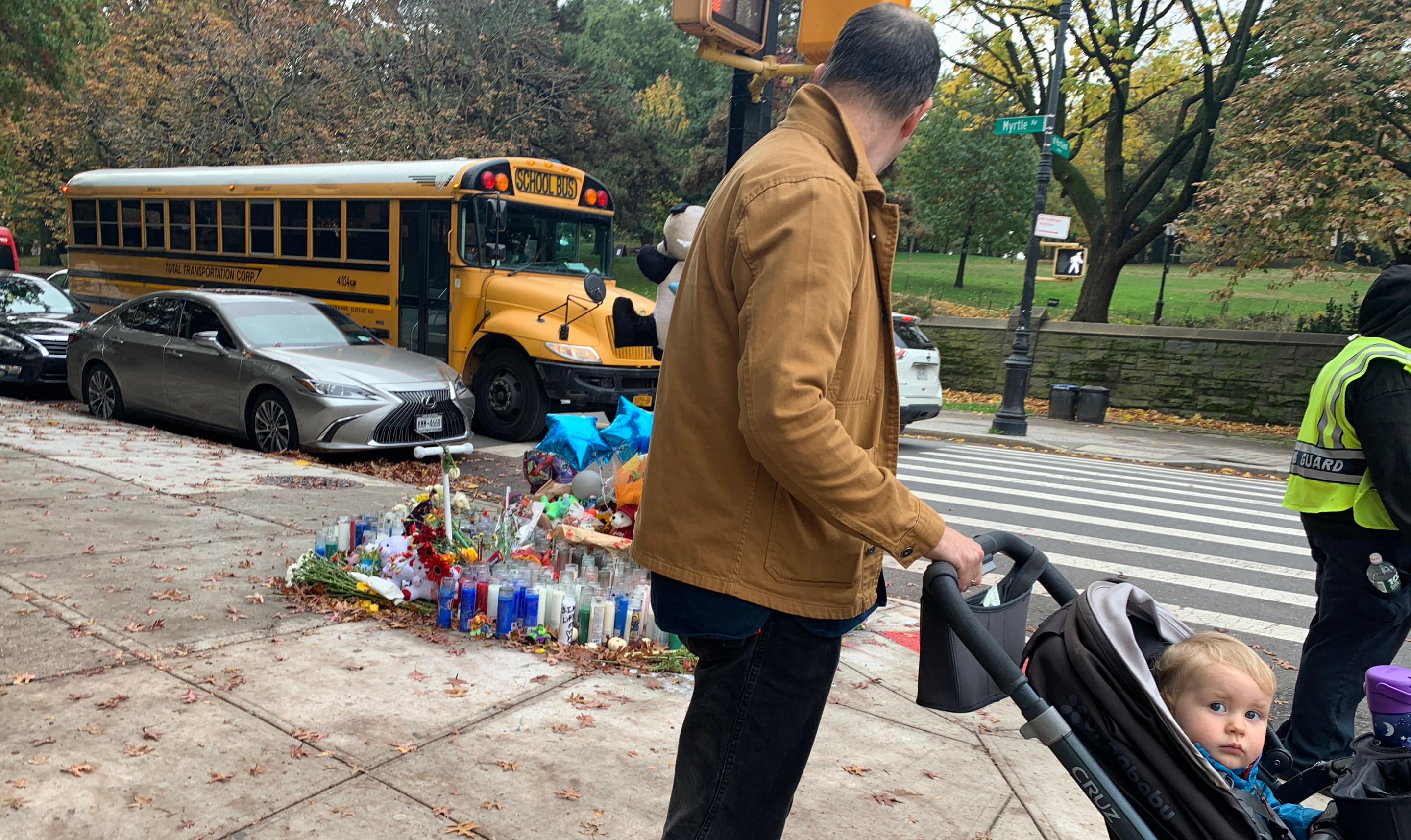They want enforcement by design.
After cops charged one of their own last week for killing a little boy with an NYPD tow truck, advocates and pols are reiterating that after-the-fact enforcement is not the answer — and are calling on the city to do more to redesign roads, including adding in daylighting, which clears intersections of parked cars that block visibility.
“This is just the latest painful incident underscoring the need for additional investments in street safety, such as by daylighting intersections, a proven safety measure that increase visibility to oncoming traffic at intersections and reduces danger for pedestrians and drivers alike,” said Council Member Selvena Brooks-Powers (D-Queens), who chairs the transportation committee.
Brooks-Powers last year introduced legislation that would require the Department of Transportation to study the safety benefits of "daylighting" and implement the measure at a minimum of 100 intersections each year, starting in 2025. The Council voted 40-7 in favor of the bill in April, just months after the high-profile death of 7-year-old Dolma Naadhun, who was killed by a reckless driver at Newtown Road and 45th Street in Astoria — an intersection that lacked daylighting to accommodate more parking.
The mayor did not sign the bill, but it became law nonetheless at the end of May, according to city records. The DOT did not respond to a request for comment about at how many intersections have been daylighted between the bill becoming law and the death of 7-year-old child, Kamari Hughes, last Thursday.
Cops charged the driver, 54-year-old Stephanie Sharp, with failure to yield to a pedestrian and failure to exercise due care, for turning onto N. Portland Avenue from Myrtle Avenue and hitting Kamari as he went to school with his mother at 7:30 a.m. Sharp was speeding and was on her phone when she plowed into the boy, witnesses said, but the driver’s alleged negligence was only partly to blame for the crash; the city’s failure to daylight the intersection is also implicated, advocates and pols charge.
Photos of the corner taken at various times show how often drivers park close to intersection as possible, even illegally encroaching on the marked crosswalk, as these Google images show:



State law prohibits drivers from parking within 20 feet of a crosswalk, but it also gave New York City permission to exempt itself from enforcing that provision, allowing drivers the right to legally park right up to the edge of pedestrian crossings.
And according to Peter Beadle, a personal injury lawyer who represents victims of crashes, that's a grave mistake for which two children and their families have already paid a deadly price.
"There's no parking within 20 feet of a crosswalk, unless posted. But the city says, 'We're exempting ourselves from that rule,'" said Beadle. "It’s so tragic and senseless that we keep letting our children and neighbors get killed when we have such easy fixes. This is a simple solution, it’s already the state rule. It’s very strange to me that a city, which correctly banned right turns on red, would nevertheless, in this instance, do the very wrong thing of not following the state rule."
Here's what the tow truck driver would have seen right before the turn. Notice that the crosswalk isn't even visible. Maybe we should't let people park so far up in intersections. pic.twitter.com/PM6cImZ62Y
— Infrastructure Week (@InfraWeek) October 26, 2023
A handful of community boards are now taking it upon themselves to demand the city axe the carveout and properly daylight intersections, including Queens Community Board 1 and Brooklyn Community Board 6.
“Daylighting is especially critical for protecting our smallest and most vulnerable pedestrians, children,” said Danny Harris, the executive director of Transportation Alternatives, highlighting another city's success of eliminating traffic deaths just across the river in Hoboken. “We need to daylight every intersection in the five boroughs now, and we're calling on the city's Department of Transportation to implement this critical safe streets infrastructure before we lose any more of our neighbors to preventable traffic violence.”
Happy that last night @QueensCB6's Transportation Committee approved sending the Full Board such a resolution. https://t.co/aaPAOWJYvM pic.twitter.com/Oydn1KUWLy
— 🚲Peter W Beadle🚲 (@pwbnyc) October 27, 2023
And while Mayor Adams said last Thursday evening after Kamari’s death that he would do “whatever it takes to keep our streets safe,” he’s done the opposite, advocates say.
Not only did Adams recently say that his administration would begin a new strategy of going door to door to solicit feedback on street redesign projects such as on Underhill Avenue, he’s also scaled back a number of previously approved street safety improvements, like on Ashland Place and McGuinness Boulevard, in deference to local business interests.
"New Yorkers have had enough with this administration’s excuses on street safety," said Harris. "How many more children have to die before Mayor Adams takes action?”
When we lose one of our babies, the entire city feels it. We feel it today after losing a seven year old angel in Brooklyn.
— Mayor Eric Adams (@NYCMayor) October 26, 2023
I spoke with this young man’s mother earlier today, and as a father of just one child as well, I can only imagine the pain she and her family are going… https://t.co/sxQghU7NHN
The DOT did not respond to multiple requests for comment.






